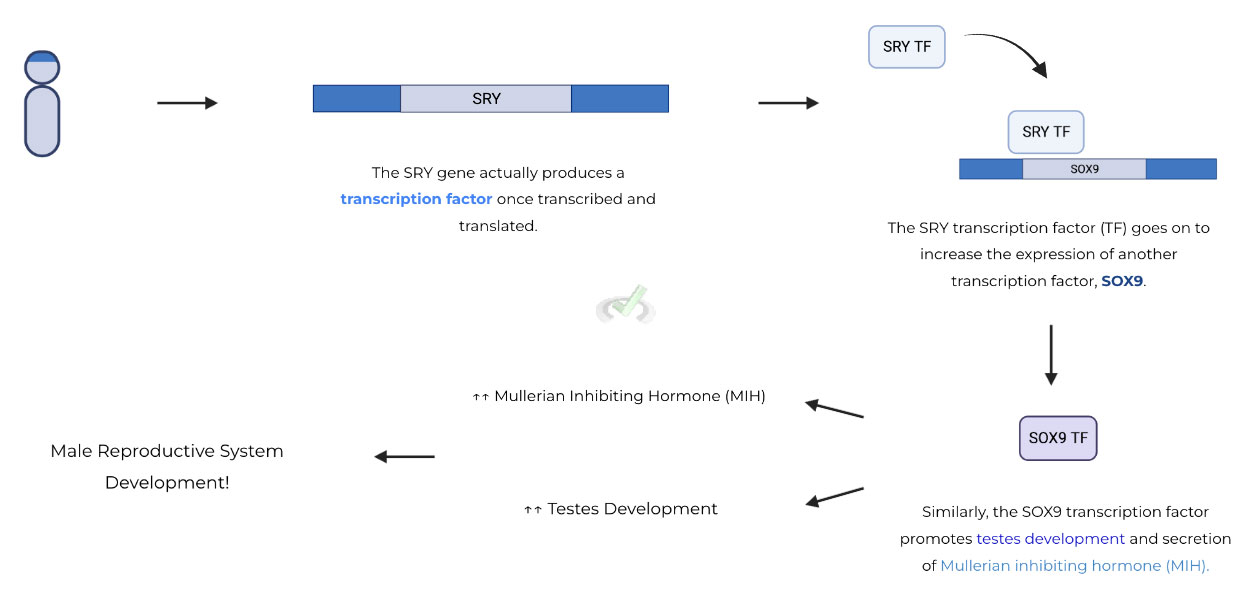I. What are Sex Hormones?
Turns out those middle and high school sex ed classes really come back to bite you! While they may have been a topic of awkward discussion at the time, these sex hormones have much needed physiological implications, especially during the onset of puberty!
These sex hormones, as stated above, play an important role in puberty, specifically when it comes to the stimulation of secondary sexual development. In addition, they are even important pre-puberty, ensuring the proper development of gonads based on the sex chromosome pairing!
Just like with the other hormones, pay special attention to how these sex hormones interact and are influenced by other hormones. Particularly, these hormones will primarily rely on interactions with the anterior pituitary gland. We cannot emphasize the importance of connecting all these different ideas and topics as a main strategy for the MCAT!
II. Content Review
We won’t go into great detail in the reproductive anatomy as you’ll find those in other articles, but we’ll at least outline the basics!
When talking about sex hormones, we are primarily focusing on the gonads, which are the sexual organs responsible for producing the sex cells (gametes) as well as house and release the sex hormones. Specifically, these include:
Male Gonads: Testes ⇒ Produce sperm cells and testosterone
Female Gonads: Ovaries ⇒ Produce egg cells and estrogens & progesterone

III. Bridge/Overlap
It might come off as a thought as to how our bodies determine which reproductive system needs to be developed. While obviously this relies on the sex chromosomes, we’ll give a bit more detailed overview on how this process works.
Your sex hormones, which are the 23rd pair of chromosomes, determine the sex and, in turn, the development of the correct reproductive system. The chromosomes only have 2 possible combinations:
XX: Female
XY: Male
**Note!: Keep in mind these sex chromosomes as they’ll be of high significance when discussing sex linked diseases!
On the Y chromosome is a gene called SRY, which stands for sex determining region Y. This gene sequence results in a transcription factor which further upregulates other transcription factors ⇒ These other transcription factors result in the further differentiation of the male gonads.

To give more context to the mullerian inhibiting hormone (MIH), gonads are at first undifferentiated when still in the embryological stage. Wolffian ducts are essentially precursors to the male reproductive system while Mullerian ducts are the precursors to the female reproductive system.
Hence, the release of the mullerian inhibiting hormone due to the Y chromosome results in the promotion of the Wolffian ducts while inhibiting formation of the Mullerian ducts ⇒ Results in male reproductive system development!
Likewise in the absent of the Y chromosome, as in the case for female sex chromosomes (XX), there is NO SRY gene resulting in the development of the female reproductive system.
IV. Wrap Up/Key Terms
Let’s take this time to wrap up & concisely summarize what we covered above in the article!
Sex Hormones:
Sex hormones are responsible for a variety of physiological outcomes, most important the secondary sexual differentiation during the onset of puberty.
The sex hormones are primarily produced and stored within the reproductive tract, specifically the gonads. In addition, as mentioned in a previous article, a small amout of sex hormones are actually produced in the adrenal cortex! The gonads include:
- Male Gonads: Testes ⇒ Produce sperm cells and testosterone
- Female Gonads: Ovaries ⇒ Produce egg cells and estrogens & progesterone
>> Pathway:
- Onset of Puberty ⇒ Hypothalamus (releases gonadotropin releasing hormone – GnRH) ⇒ Anterior Pituitary (releases follicular stimulating and lutenizing hormone – FSH & LH) ⇒ Reproductive Gonads ⇒ Secondary Sexual Differentiation
The sex chromosomes (23rd pair) determines the sex of an individual and will either be 1) XX (female) or 2) XY (male).
- The Y chromosome contains a gene region called SRY (sex determining region Y) ⇒ Results in the production of a transcription factor which promotes the differentiation of the male reproductive system.
V. Practice
Take a look at these practice questions to see and solidify your understanding!
Sample Practice Question 1
The release of the luteinizing hormone (LH) and the follicular stimulating hormone (FSH) on the ovaries results in the release of ____________. Furthermore, LH and FSH can be best described as ____________.
A. Estrogen & Progesterone; Tropic Hormone
B. Estrogen & Progesterone; Direct Hormone
C. Testosterone; Tropic Hormone
D. Testosterone; Direct Hormone
Ans. A.
As stated in the question stem, LH and FSH will go on to stimulate the ovaries, resulting in the release of estrogen and progesterone. If they rather stimulated the testes, testosterone would be released.
In addition, because the interaction of LH and FSH with the ovaries results in the release of another hormone, they can be best described as a tropic hormone.
Sample Practice Question 2
Based on its name, specifically the ending suffix, where would testosterone’s receptor be located?
A. Intracellular/Intranuclear
B. Extracellular
C. Both intracellular/intranuclear & extracellular
D. Neither intracellular/intranuclear & extracellular
Ans. A.
Again, it’s important to make connections between the different study topics you’ll encounter during MCAT prep! Testosterone ends in the suffix “-one” which indicates it’s derived from an cholesterol backbone ⇒ Just like aldosterone and cortisone!
Because it’s derived from a cholesterol backbone, this indicates that the hormone has nonpolar, hydrophobic characteristics ⇒ Should have only an intracellular/intranuclear receptor because the hydrophobic character allows the hormone to pass through the membrane to bind to the receptor.



 To help you achieve your goal MCAT score, we take turns hosting these
To help you achieve your goal MCAT score, we take turns hosting these 
























